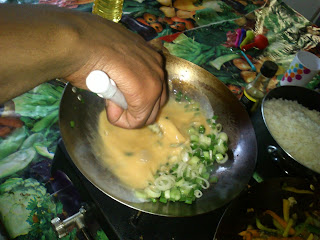There was another full house on Saturday morning (23 February) for one of Rob's famous breadmaking sessions. Despite it being so chilly outside, inside, the room soon warmed up with the heat from all the ovens - a perfect temperature to
help the dough rise, and giving everyone rosy cheeks all round.
On the menu today were basic loaves, garlic naan bread, and focaccia with olives, sundried tomatoes, rosemary and olive
oil. As an added treat, two of the
trainee cooks who were helping out made pizzas for us all to share for lunch - homemade dough and basic tomato
sauce with toppings of cheese, anchovies and olives.
After the initial introductions, it was time for everyone in the group to start measuring flour, yeast, sugar, salt and water to make the dough for our loaves. Covering the bowls with tea towels, we left the balls to rest and rise in the warm atmosphere, while we tidied up before the kneading stage, learning that Bakers Mates are exactly that - a simple,
essential and effective utensil, great for mixing ingredients, scraping off
hardened dough mixture, and even cleaning down surfaces - a must for every budding
breadmaker.
Next, we split into groups to make naan dough and focaccia dough. No salt was necessary for the naan dough as
it was already present from the handmade garlic paste, which we made by slicing and chopping
fresh garlic and mixing with sea salt to form a paste. Yoghurt was used instead of water, gently heating it in a pan using a finger to stir rather than a spoon, enabling the
correct temperature to be reached - and saving on the washing-up! Once ready, the naan dough was rolled out and fried in hot oil, taking care to avoid hot oil splashes.
The loaves were put into the oven and then it was time to work on the focaccia. The dough was stretched to the size of
a large roasting tin, left to rise then scattered with sliced olives and sundried tomatoes, folded over, rolled a little, then sprinkled with thick slices of
organic red onions, fresh rosemary and rock salt. They then went in the oven for about
25 minutes.
It wasn't long before some heavenly bread smells filled the room, and soon the
loaves were ready to check. Rob showed us the best way was to fold a tea towel long ways and hold the base of the bread tin with one end, and let the loaf fall out into the other end and check it by tapping the bottom.
There was time at the end of the session to sit down and admire and sample all the baking, then eat the freshly baked pizza slices together as a group. These are always sell-out sessions and it really is a great way to spend a Saturday morning
- cooking from scratch, using fresh, locally sourced ingredients, learning new skills, chatting with fellow food lovers, being in a sociable, relaxed environment, and
taking home a freshly baked loaf of bread, a spectacular rustic focaccia, and a
garlic naan without going to the shops.
There are more photographs from this session on our Facebook page.
We're running our first full-day breadmaking session on Saturday 20 April; see the CGF website for full details. If you can't make that, we are planning more baking sessions over the coming months, so watch this space!



















